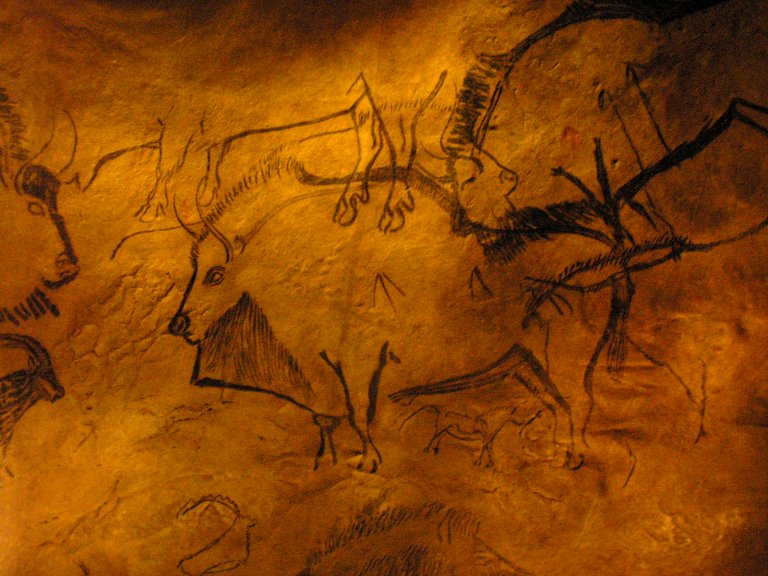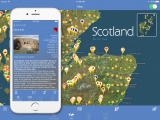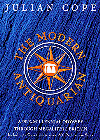<< Our Photo Pages >> Grotte de Niaux - Cave or Rock Shelter in France in Midi:Ariège (09)
Submitted by TheCaptain on Thursday, 14 August 2008 Page Views: 22185
Natural PlacesSite Name: Grotte de Niaux Alternative Name: Grotte de la CalbièreCountry: France Département: Midi:Ariège (09) Type: Cave or Rock Shelter
Nearest Town: Tarascon-sur-Ariège Nearest Village: Niaux
Latitude: 42.819730N Longitude: 1.593660E
Condition:
| 5 | Perfect |
| 4 | Almost Perfect |
| 3 | Reasonable but with some damage |
| 2 | Ruined but still recognisable as an ancient site |
| 1 | Pretty much destroyed, possibly visible as crop marks |
| 0 | No data. |
| -1 | Completely destroyed |
| 5 | Superb |
| 4 | Good |
| 3 | Ordinary |
| 2 | Not Good |
| 1 | Awful |
| 0 | No data. |
| 5 | Can be driven to, probably with disabled access |
| 4 | Short walk on a footpath |
| 3 | Requiring a bit more of a walk |
| 2 | A long walk |
| 1 | In the middle of nowhere, a nightmare to find |
| 0 | No data. |
| 5 | co-ordinates taken by GPS or official recorded co-ordinates |
| 4 | co-ordinates scaled from a detailed map |
| 3 | co-ordinates scaled from a bad map |
| 2 | co-ordinates of the nearest village |
| 1 | co-ordinates of the nearest town |
| 0 | no data |
Internal Links:
External Links:
I have visited· I would like to visit
43559959 would like to visit
XIII visited on 8th Jun 2022 - their rating: Cond: 5 Amb: 5 Access: 4
J_W_R visited on 27th Aug 2021 - their rating: Cond: 5 Amb: 5 Access: 3
NickyD visited on 1st Jul 2013 - their rating: Cond: 5 Amb: 4 Access: 3
TheCaptain saw from a distance on 11th Sep 2005 - their rating: Access: 4 The world famous cave, known for its tremendous paintings of bison and horses, is easily found just up a small valley to the west of Tarascon, and is signposted from all around, you can hardly miss it. The cave is up the hillside from the village of Niaux with its museum, and is situated opposite to the Grotte de la Vache.
The modern day entrance, with its rusting iron "artwork" is high up the hillside in an enormous opening, which was not the original entrance to the cave in ancient times, which was further down in the valley. Visits are year round, but only a few people are allowed in on any day to help preserve the conditions inside, so it is usually necessary to book your visit in advance.
TheCaptain visited on 16th Apr 2000 - their rating: Cond: 5 Amb: 5 Access: 4 Full guided visit Grotte de Niaux with Sean. Fabulous. So glad I booked this up last week.
TheCaptain visited on 2nd Apr 2000 - their rating: Access: 4 Grotte de Niaux near Tarascon in Ariège. Check out the world famous Niaux caves for a possible visit soon. The main entrance to the fabulous Niaux cave used for visitors is now further up the hillside than it once was. In ancient times, there would have been several lower, smaller entrances.
Kuba visited - their rating: Cond: 5 Amb: 5 Access: 4
Average ratings for this site from all visit loggers: Condition: 5 Ambience: 4.8 Access: 3.71

The cave is up the hillside from the village of Niaux with its museum, and is situated opposite to the Grotte de la Vache. The modern day entrance, with its rusting iron "artwork" is high up the hillside in an enormous opening, which was not the original entrance to the cave in accient times, which was further down in the valley.
Visits are year round, but only a few people are allowed in on any day to help preserve the conditions inside, so it is wise to book your visit well in advance. Hence low Access score.
Information and Pictures
hominides.com
Note: See comment for acoustic theory relating to this and other French caves
You may be viewing yesterday's version of this page. To see the most up to date information please register for a free account.























Do not use the above information on other web sites or publications without permission of the contributor.
Click here to see more info for this site
Nearby sites
Click here to view sites on an interactive map of the areaKey: Red: member's photo, Blue: 3rd party photo, Yellow: other image, Green: no photo - please go there and take one, Grey: site destroyed
Download sites to:
KML (Google Earth)
GPX (GPS waypoints)
CSV (Garmin/Navman)
CSV (Excel)
To unlock full downloads you need to sign up as a Contributory Member. Otherwise downloads are limited to 50 sites.
Turn off the page maps and other distractions
Nearby sites listing. In the following links * = Image available
289m SSE 159° Grotte de la Petite Caougno* Cave or Rock Shelter
488m WNW 282° Grotte de La Vache* Cave or Rock Shelter
1.9km ENE 78° Grotte de Lombrives* Cave or Rock Shelter
2.1km NNW 340° Dolmen de la Plagne Burial Chamber or Dolmen
2.1km SSW 212° Dolmen de Quiernès Natural Stone / Erratic / Other Natural Feature
2.4km ENE 69° Grotte des Eglises Cave or Rock Shelter
3.0km NNE 23° Musée de Tarascon Museum
4.3km ESE 103° Grotte de Fontanet Cave or Rock Shelter
4.3km NNW 339° Parc Pyrénéen de l'Art Préhistorique* Museum
6.1km NNW 342° Grotte de Bédeilhac* Cave or Rock Shelter
7.4km NNE 15° Dolmen de Peyrogall* Burial Chamber or Dolmen
8.6km SW 230° Palet de Sanson* Natural Stone / Erratic / Other Natural Feature
16.1km N 4° Grotte de Cheval Cave or Rock Shelter
16.2km N 3° Musée Départemental de l'Ariège* Museum
17.6km ESE 115° La Cabane de Rolana* Burial Chamber or Dolmen
17.7km NNE 19° Grotte de l'Herm Cave or Rock Shelter
20.4km ENE 74° Montségur museum* Museum
20.4km ENE 72° Montségur* Ancient Village or Settlement
21.0km ESE 119° Menhir de Savignac-les-Ormeaux* Standing Stone (Menhir)
22.7km ENE 69° Roc de Fougasse Natural Stone / Erratic / Other Natural Feature
23.5km WNW 291° Grotte du Ker de Massat* Cave or Rock Shelter
23.8km N 349° Grotte du Portel* Cave or Rock Shelter
26.0km NW 320° Hautech ancient copper mine Ancient Mine, Quarry or other Industry
26.5km NW 314° Rougé ancient copper mine Ancient Mine, Quarry or other Industry
27.7km ENE 74° Source de Fontestorbes* Holy Well or Sacred Spring
View more nearby sites and additional images






 We would like to know more about this location. Please feel free to add a brief description and any relevant information in your own language.
We would like to know more about this location. Please feel free to add a brief description and any relevant information in your own language. Wir möchten mehr über diese Stätte erfahren. Bitte zögern Sie nicht, eine kurze Beschreibung und relevante Informationen in Deutsch hinzuzufügen.
Wir möchten mehr über diese Stätte erfahren. Bitte zögern Sie nicht, eine kurze Beschreibung und relevante Informationen in Deutsch hinzuzufügen. Nous aimerions en savoir encore un peu sur les lieux. S'il vous plaît n'hesitez pas à ajouter une courte description et tous les renseignements pertinents dans votre propre langue.
Nous aimerions en savoir encore un peu sur les lieux. S'il vous plaît n'hesitez pas à ajouter une courte description et tous les renseignements pertinents dans votre propre langue. Quisieramos informarnos un poco más de las lugares. No dude en añadir una breve descripción y otros datos relevantes en su propio idioma.
Quisieramos informarnos un poco más de las lugares. No dude en añadir una breve descripción y otros datos relevantes en su propio idioma.